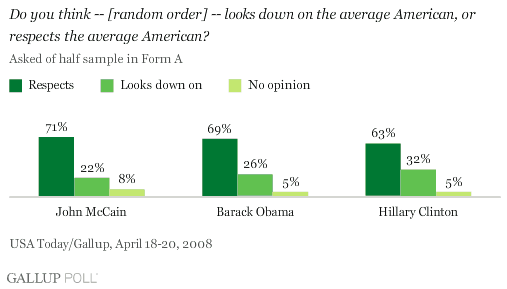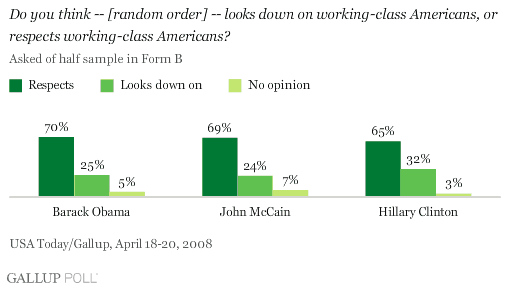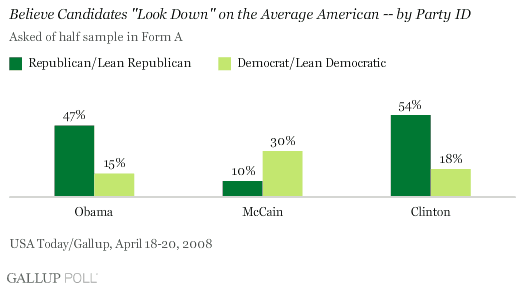PRINCETON, NJ -- Most Americans reject the suggestion that any of the leading presidential candidates look down on the average American -- though more say it applies to Hillary Clinton (32%) than to Barack Obama (26%) or John McCain (22%).

Nearly identical results are produced when the question asks specifically about "working-class" Americans, rather than "average" Americans.

The campaign flap over how the candidates perceive average Americans stems from Obama's recent comments about the psychology of working-class, small-town voters in Pennsylvania, saying, "And it's not surprising then they get bitter, they cling to guns or religion or antipathy to people who aren't like them or anti-immigrant sentiment or anti-trade sentiment as a way to explain their frustrations."
Sens. Clinton and McCain have both labeled these comments "elitist," and Clinton, in particular, has tried to capitalize on them leading up to Tuesday's crucial Pennsylvania primary election. But, as noted, according to the new USA Today/Gallup poll, conducted April 18-20, only 26% of Americans believe Obama "looks down on the average American" -- a smaller percentage than say this of Clinton -- while 69% think he "respects" the average American.
Gallup finds no difference in perceptions about Obama's outlook among high- versus low-income Americans. Also, there is virtually no difference among Democrats in the percentages saying Obama and Clinton each look down on average Americans -- 15% and 18%, respectively.
The "elitism" charge could play a bigger role in the national election -- working against the Democrats -- as roughly half of Republicans perceive that both Clinton and Obama look down on average Americans. Less than a third of Democrats say this about McCain.

Survey Methods
Results are based on telephone interviews with 1,016 national adults, aged 18 and older, conducted April 18-20, 2008. For results based on the total sample of national adults, one can say with 95% confidence that the maximum margin of sampling error is ±3 percentage points.
For results based on the 506 national adults in the Form A half-sample and 510 national adults in the Form B half-sample, the maximum margins of sampling error are ±5 percentage points.
Interviews are conducted with respondents on land-line telephones (for respondents with a land-line telephone) and cellular phones (for respondents who are cell-phone only).
In addition to sampling error, question wording and practical difficulties in conducting surveys can introduce error or bias into the findings of public opinion polls.
To provide feedback or suggestions about how to improve Gallup.com, please e-mail feedback@gallup.com.
